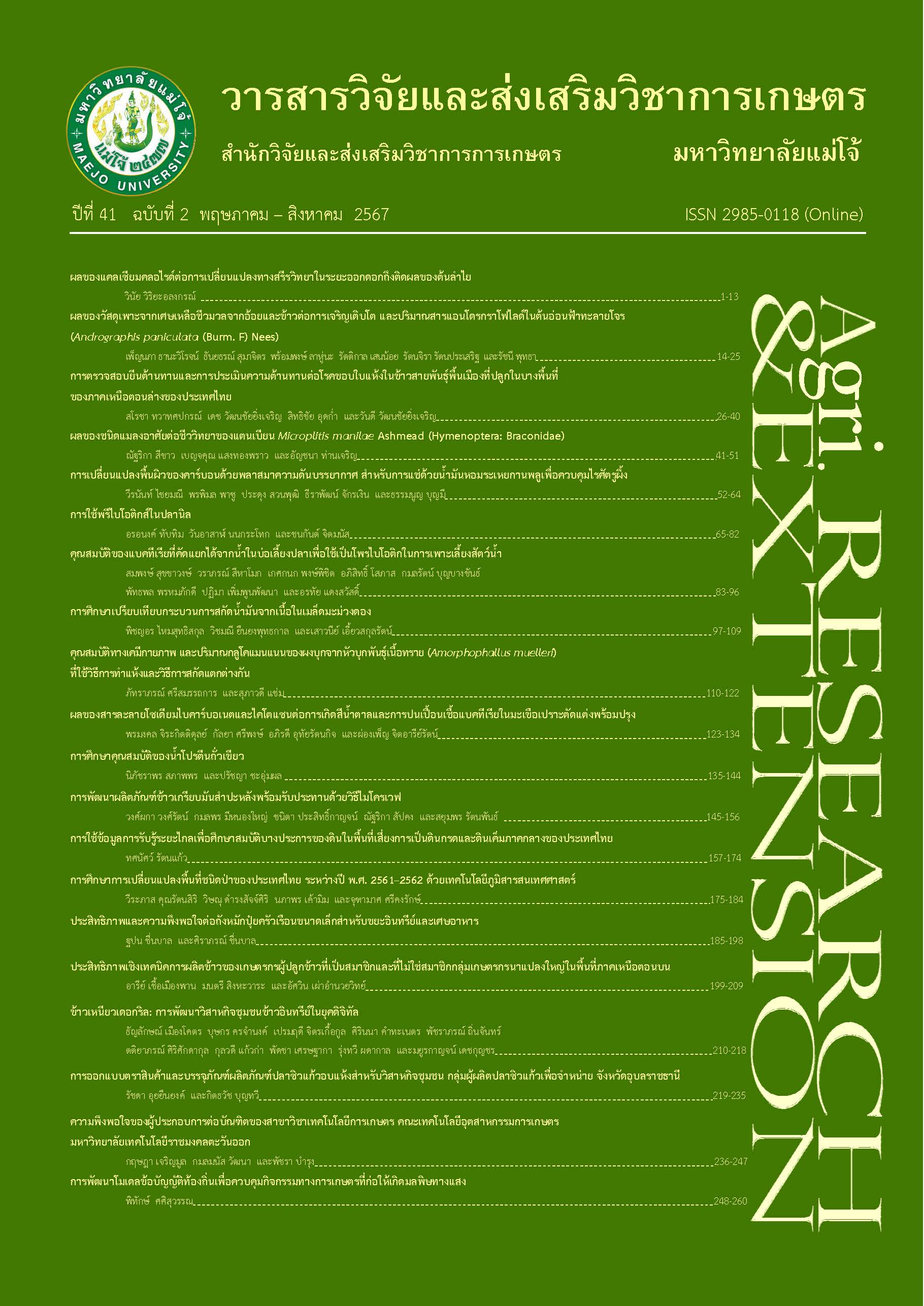ประสิทธิภาพและความพึงพอใจต่อถังหมักปุ๋ยครัวเรือนขนาดเล็ก สำหรับขยะอินทรีย์และเศษอาหาร
DOI:
https://doi.org/10.14456/jare-mju.2024.35คำสำคัญ:
ถังหมักปุ๋ย, ขยะอินทรีย์และเศษอาหาร, วัสดุปรับปรุงดินบทคัดย่อ
งานวิจัยนี้มีวัตถุประสงค์เพื่อพัฒนาถังหมักปุ๋ยครัวเรือนขนาดเล็กสำหรับขยะอินทรีย์และเศษอาหาร และเพื่อศึกษาประสิทธิภาพของถังหมักและความพึงพอใจของผู้ใช้งานถังหมัก การศึกษาแบ่งออกเป็น 3 ชุดการทดลอง ได้แก่ T1) ถังหมักแบบไม่มีท่อระบายอากาศเป็นแกนกลาง T2) ถังหมักแบบมีท่อระบายอากาศเป็นแกนกลาง และ T3) ถังหมักแบบมีท่อระบายอากาศเป็นแกนกลางและหัวเชื้อจุลินทรีย์ 10% โดยวัสดุหมัก ได้แก่ เศษผัก เศษผลไม้ ข้าว และใบไม้แห้ง ในอัตราส่วน 1:1:1:1 โดยน้ำหนัก มีค่า C/N เริ่มต้นที่ 48 ใส่วัสดุหมักจำนวน 1 กิโลกรัม อย่างต่อเนื่อง เป็นระยะเวลา 15 วัน ปล่อยหมักทิ้งไว้ 15 วัน และทำซ้ำเช่นเดิมอีกครั้ง ผลการทดลองพบว่าอุณหภูมิในถังหมักทั้ง 3 ชุดการทดลองไม่แตกต่างกัน ในขณะที่ค่า pH และ EC มีความแตกต่างกันอย่างมีนัยสำคัญทางสถิติ ที่ระดับความเชื่อมั่น 95% หลังสิ้นสุดการทดลอง พบว่าคุณสมบัติของวัสดุปรับปรุงดินที่ได้นั้น T3 มีคุณสมบัติที่ดีกว่าในชุดการทดลองอื่น ๆ โดยพบว่ามีค่า pH EC และ C/N ที่ 7.2, 1.2260 dS/CM และ 18 ตามลำดับ นอกจากนี้น้ำหมักมีปริมาณกรดฮิวมิค 1.1% เมื่อนำชุดการทดลอง T3 ซึ่งประกอบด้วยถังหมักแบบมีท่อระบายอากาศเป็นแกนกลางและเชื้อจุลินทรีย์ที่ถูกตรึง 10% ไปทดสอบกับกลุ่มตัวอย่างจำนวน 10 ครัวเรือน หลังจาก 2 เดือนของการใช้ ผู้ใช้งานประเมินความพึงพอใจผ่านแบบสอบถาม พบว่ามีระดับความพึงพอใจของการใช้ถังหมักปุ๋ยโดยรวมอยู่ที่ 4.5±0.8
เอกสารอ้างอิง
Ahmad, R., G. Jilani, M. Arshad, Z. Zahir and A. Khalid. 2007. Bio-conversion of organic wastes for their recycling in agriculture: an overview of perspectives and prospects. Annals of Microbiology 57(4): 471-479.
Chandenduang, C. 2007. Composting. Design & Manufacturing 48: 48-54. [in Thai]
Cheunbarn, T., S. Cheunbarn and R. Rinaphat. 2020. Handbook on Technology Transfer for the Utilization of Agricultural Microorganisms. 14 p. In Research Report. Chiang Mai: Maejo University. [in Thai]
Ezgarden. 2023. Article: EC and pH of each plant. [Online]. Available http://www.ezgarden.net (February 10, 2023). [in Thai]
Karnchanawong, S. and N. Suriyanon. 2011. Household organic waste composting using bins with different types of passive aeration resources. Conservation and Recycling 55(5): 548-553.
Land Development Department (LDD). 2013. Regulations on the use of agricultural production factors standard certification marks. [Online]. Available https://osd101.ldd.go.th/q/manual/A02.pdf (February 10, 2023). [in Thai]
Lankongpoon, T. 2017. Effective Air Inlet and Outlet Pattern for Passive Composting Bin. Master Thesis. Prince of Songkla University. 106 p.
Mala, T. 2003. Organic fertilizers; biofertilizers; production technology and utilization. [Online]. Available https://kukr.lib.ku.ac.th/kukr_es/index.php?/kukr/search_detail/result/184338 (October 11, 2023). [in Thai]
McKinley, S.P. 2008. Physical Chemical Process and Environmental Impacts Associated with Home Composting. Doctoral Dissertation. University of Southampton. 222 p.
Pan, L., B. Dam and S.K. Sen. 2012. Composting of common organic wastes using microbial inoculants. Biotech. 2: 127-134.
Panitpichet, P. 2017. Greenhouse gas reduction from solid waste management. [Online]. Available http://conference.tgo.or.th/download/tgo_or_th/Article/2017/Waste_GHGs.pdf (February 10, 2023). [in Thai]
Pedro, M.S., S. Haruta, K. Nakamura, M. Hazaka, M. Ishii and Y. Igarashi. 2003. Isolation and characterization of predominant microorganisms during decomposition of waste materials in a field-scale composter. J. Biosci Bioeng. 95: 368-373.
Pollution Control Department (PCD). 2020. Report on the Situation of Municipal Solid Waste in Thailand 2016. [Online]. Available https://www.pcd.go.th/publication/3811 (February 10, 2023). [in Thai]
Rangseesuriyachai, T. and K. Saricheewin. 2017. Study of organic waste composting with aeration and use of crude enzyme. Journal of Engineering, RMUT 16(2): 1-12. [in Thai]
Riddech, N. 2013. What should we consider before making compost? KKU Science Journal 41(3): 595-606. [in Thai]
Saithep, N. 2009. Selection of Bio-degrading Microorganism for Short-term Composting Process. Doctoral Dissertation. Chiang Mai University. 186 p.
Stentiford, E.T. 1996. Composting Control: Principle and Practice. pp. 49-59. In de Bertoldi, M., P. Sequi, B. Lemmes, T. Papi (eds.). The Science of Composting: Past I. London: Chapman & Hall.
Tancho, A. 2006. Applied Natural Agriculture: Principles, Concepts, and Practices of Thailand. Pathum Thani: National Science and Technology Development Agency. 300 p. [in Thai]
Tancho, A. 2015. Principles of high quality industrial organic fertilizer production. Thai Journal of Soil and Fertilizer 37(1-4): 30-39. [in Thai]
Tchobanoglous, G., H. Theisen and S. Vigil. 1993. Integrated Solid Waste Management: Engineering Principles and Management Issues. Singapore: McGraw-Hill. 978 p.
United Nations Environment Programme (UNEP). 2021. UNEP Food Waste Index Report 2021. [Online]. Available https://wedocs.unep.org/handle/20.500.11822/35280;jsessionid=B711DBAF2A01BD795E689595F65C04CF (August 1, 2022).
USDA. 2019. Principles of Composting. Part 637 National Engineering Handbook. Chapter 2. [Online]. Available https://directives.sc.egov.usda.gov/viewerFS.aspx?id=3850 (February 10, 2023).
ดาวน์โหลด
เผยแพร่แล้ว
รูปแบบการอ้างอิง
ฉบับ
ประเภทบทความ
สัญญาอนุญาต
ลิขสิทธิ์ (c) 2024 วารสารวิจัยและส่งเสริมวิชาการเกษตร

อนุญาตภายใต้เงื่อนไข Creative Commons Attribution-NonCommercial-NoDerivatives 4.0 International License.
บทความนี้ได้รับการเผยแพร่ภายใต้สัญญาอนุญาต Creative Commons Attribution-NonCommercial-NoDerivatives 4.0 International (CC BY-NC-ND 4.0) ซึ่งอนุญาตให้ผู้อื่นสามารถแชร์บทความได้โดยให้เครดิตผู้เขียนและห้ามนำไปใช้เพื่อการค้าหรือดัดแปลง หากต้องการใช้งานซ้ำในลักษณะอื่น ๆ หรือการเผยแพร่ซ้ำ จำเป็นต้องได้รับอนุญาตจากวารสาร





